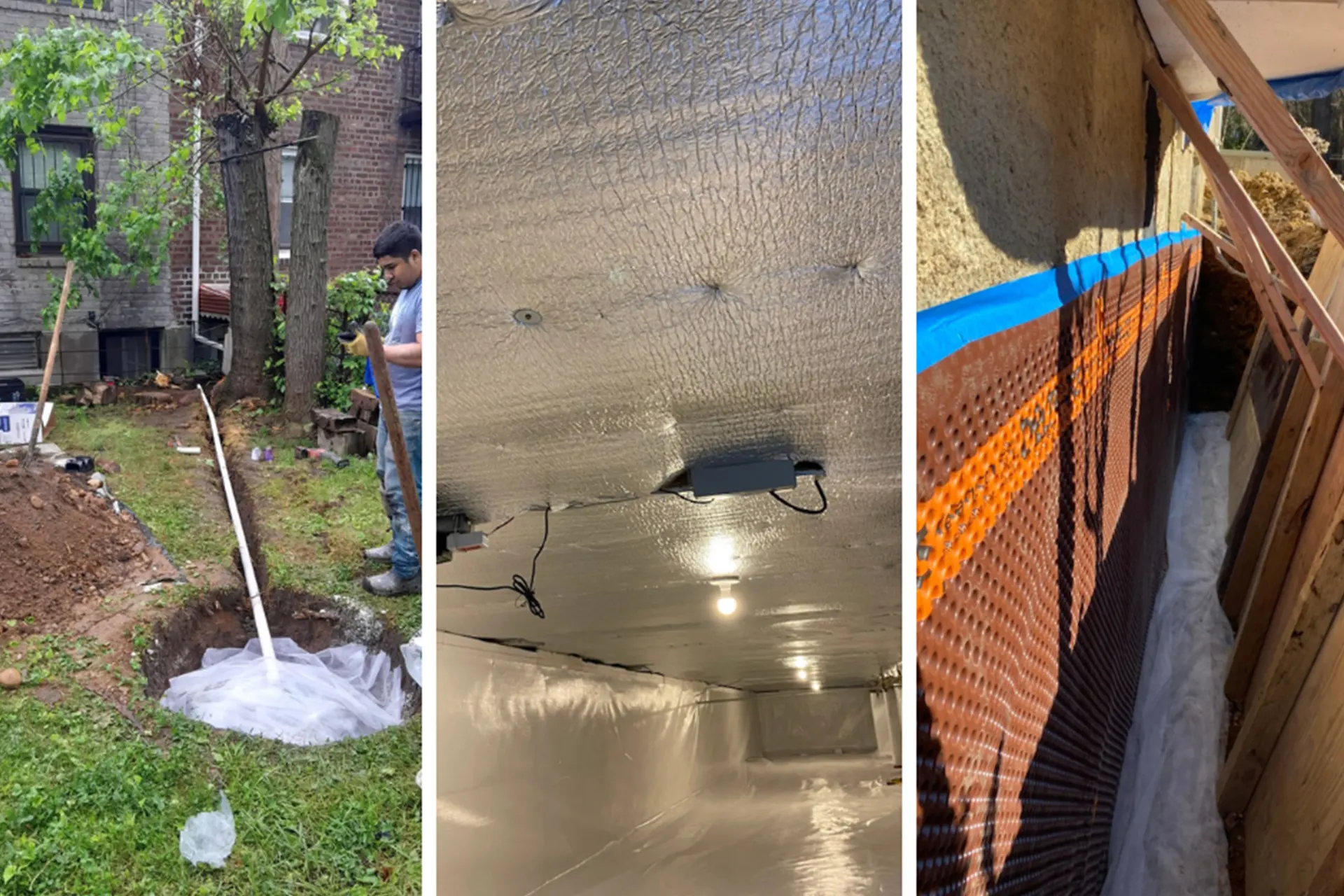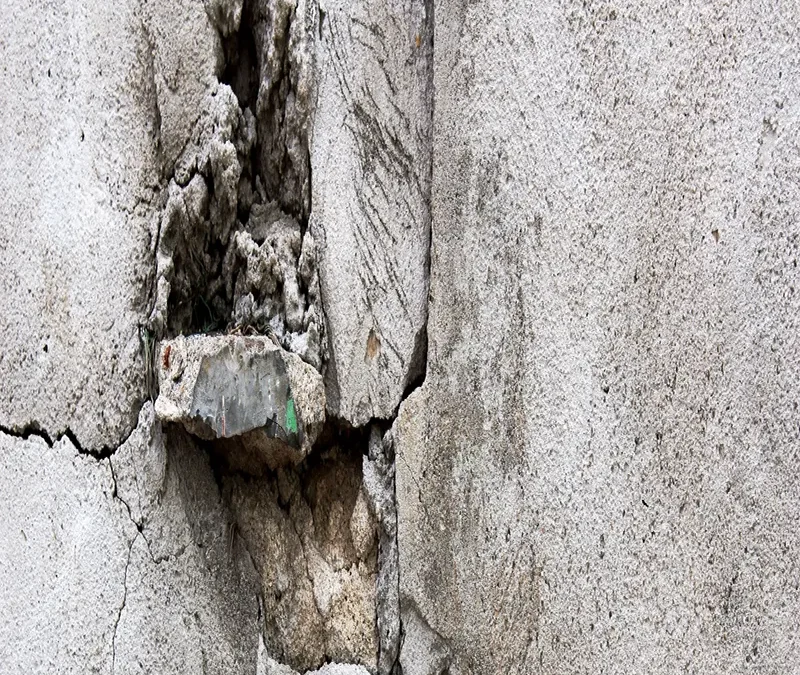Foundation damage is one of the most serious threats a property can face, yet it’s often overlooked until the warning signs start showing up. And let’s be honest… As a homeowner, cracked walls, sloping floors, sticking doors, or flooding basements are impossible to ignore. Left untreated, these problems compromise structural safety, drain property value, trigger mold growth, and expose owners to liability. Nationally, the average cost of foundation repair can range from $4,000 to $50,000+, depending on severity, making early action critical for homeowners and property managers.
In this guide, we’ll break down the leading causes of foundation damage, explore how soil, water, and environmental forces create risks, and highlight unique challenges foundations face in Long Island. We’ll also show you how to choose the right contractor to protect your property if you live outside of New York, and let you know why we’re the best contractor in New York to call on if you live here.
Discover the Causes of Foundation Damage and Schedule Your Free Foundation Inspection Today!
Understanding the Causes of Foundation Damage
Foundation problems rarely stem from a single issue. Instead, they result from multiple factors like soil conditions, water intrusion, poor construction, and environmental forces working together. The causes of foundation damage vary widely between residential homes and commercial buildings, but every type of property shows warning signs that can’t be ignored.
In the sections below, we’ll break down each major cause, explain how it affects structural stability, and outline proven repair strategies so you know exactly what to look for and how to fix it before the problem escalates.
Understanding the Causes of Foundation Damage: Quick Reference Table
| Cause of Foundation Damage | Common Damage Signs | Proven Repair Methods | Local CTA |
|---|---|---|---|
| Water Intrusion & Drainage Problems | Cracked/bowed walls, standing water, mold growth, settlement from saturated soils | French drains, sump pumps, grading, exterior waterproofing, interior sealants & drains | Not sure if water is the culprit? Get a free site assessment today! |
| Expansive Clay Soils (Shrink-Swell) | Slab heave, diagonal cracks, uneven floors, sticky doors/windows | Deep foundation systems (micropiles, helical piers), moisture barriers, soil stabilization, controlled drainage | Living on clay soils? Schedule a foundation inspection before damage spreads! |
| Poor Construction Practices | Premature settling, thin/cracked slabs, leaning/tilting walls | Underpinning, footing reinforcement, retrofits to meet modern codes | Buying an older property? Get a foundation evaluation before you invest! |
| Hydrostatic Pressure | Bowed walls, water seepage, basement flooding | Weep holes with gravel backfill, exterior membranes, interior drainage & pump systems | Worried about basement walls under pressure? Schedule a free inspection today! |
| Frost Heave & Freeze-Thaw Cycles | Cracked slabs/driveways, uplift of shallow foundations, leaks from freeze-thaw cracks | Frost-protected shallow foundations, insulated footings, improved drainage | Facing cold-weather cracks? Protect your foundation now! |
| Seepage & Erosion Around Foundations | Exposed footings, uneven floors, instability near slopes/coastal zones | Regrading, riprap/vegetation, retaining walls, soil stabilization | Near sandy soils or coastal zones? Get an erosion & foundation risk assessment today! |
| Tree Roots & Vegetation | Differential settlement, cracked slabs/sidewalks, blocked drains | Root barriers, controlled landscaping, underpinning | Planting near your home? Get a professional root impact assessment! |
| Surcharge Loads (Vehicles, Stockpiles, Adjacent Buildings) | Leaning retaining walls, settlement under driveways, cracked foundations from nearby loads | Helical tiebacks, load distribution beams, deeper foundation design | Experiencing extra pressure? Schedule a surcharge load & foundation assessment today! |
Water Intrusion & Drainage Problems and Foundation Damage
Water is one of the most destructive forces acting against foundations. Poor drainage, leaking gutters, and basement seepage drive water directly against structural walls, creating pressure and long-term weakening. When soils become oversaturated, hydrostatic pressure builds, pushing inward until cracks, leaks, or even wall bowing occurs.
Nationally, water damage accounts for over 20% of all property insurance claims, costing billions annually. On Long Island, flood-prone zones and high groundwater levels make basement seepage and storm-related flooding a leading cause of foundation problems.
Foundation Damage Caused by Water Intrusion & Drainage Problems:
- Cracked or bowed basement walls
- Standing water and basement flooding
- Mold growth and air quality issues
- Foundation settlement from saturated soils
Repair Methods for Foundation Damage Caused by Water Intrusion & Drainage Problems:
- Install French drains or sump pumps
- Grade soil away from the structure
- Exterior waterproofing systems
- Interior sealants and drainage channels
Not Sure If Your Foundation Damage Is From Water? Get a Free Site Assessment Today!
Expansive Clay Soils (Shrink-Swell Behavior) and Foundation Damage
Expansive clay soils are one of the most notorious causes of foundation problems. These soils expand dramatically when wet and shrink as they dry, a process known as shrink-swell behavior. Engineers measure this risk using Atterberg Limits and the Plasticity Index (PI) with PI values over 15 flagged by the NYC Department of Buildings as expansive.
When these soils swell, they can lift slabs and push against foundation walls; when they shrink, they create voids that lead to settlement. On Long Island, clay-heavy soils in parts of Nassau and Queens frequently cause cracked walls and uneven floors in both residential and commercial properties.
Foundation Damage Caused by Expansive Clay Soils:
- Slab heave and floor lifting
- Diagonal wall cracks
- Foundation movement during wet/dry cycles
- Sticky doors and windows
Repair Methods for Foundation Damage Caused by Expansive Clay Soils:
- Deep foundation systems (micropiles, helical piers)
- Moisture barriers or soil stabilization treatments
- Controlled drainage and irrigation systems
Living On Clay Soils? Schedule a Foundation Inspection Before Damage Spreads!
Poor Construction Practices and Foundation Damage
Not all foundation problems are caused by soil or water. Sometimes the issue starts with how the structure was built. Poor soil compaction, undersized footings, or inadequate reinforcement can cause premature failure, even in otherwise stable ground. In many parts of New York City, aging housing stock was built under outdated codes or with shortcuts that wouldn’t pass modern inspections.
Over time, these weaknesses show up as cracks, leaning walls, and settlement that accelerate under environmental stress. This is one of the most common hidden risks for buyers of older homes and commercial properties.
Foundation Damage Caused by Poor Construction Practices:
- Premature settling or sinking
- Thin or cracked slabs
- Leaning or tilting walls
Repair Methods for Foundation Damage Caused by Poor Construction Practices:
- Underpinning to deeper soils
- Reinforcement of footings
- Retrofitting foundations to meet modern standards
Buying an Older Property? Get a Foundation Evaluation Before You Invest!
Hydrostatic Pressure and Foundation Damage
When groundwater builds up around a foundation, it exerts powerful lateral force on basement walls. This phenomenon, called hydrostatic pressure, is one of the leading causes of wall bowing, cracking, and leaks. In flood-prone zones of Long Island and Queens, high water tables and poor drainage make basements especially vulnerable.
Over time, even well-built concrete walls can’t withstand the constant push of saturated soils, leading to structural instability and costly flooding. Understanding and relieving hydrostatic pressure is critical to protecting both residential and commercial foundations.
Foundation Damage Caused by Hydrostatic Pressure:
- Bowing or bulging walls
- Water seepage through cracks
- Basement flooding
Repair Methods for Foundation Damage Caused by Hydrostatic Pressure:
- Weep holes with gravel backfill
- Exterior waterproofing membranes
- Interior drainage and pump systems
Worried About Basement Walls Under Pressure? Schedule a Free Foundation Inspection Today!
Frost Heave & Freeze-Thaw Cycles and Foundation Damage
Frost heave occurs when water in the soil freezes, expands, and pushes upward on foundations and slabs. In the Northeast, especially New York and Long Island, repeated freeze-thaw cycles put enormous stress on shallow foundations, driveways, and basement walls.
Each cycle of freezing and thawing widens cracks, shifts soil, and allows more water intrusion, compounding the damage year after year. Without protective design or drainage, properties in colder climates face significant risks of uneven settlement and long-term structural problems.
Foundation Damage Caused by Frost Heave & Freeze-Thaw Cycles:
- Cracked slabs or driveways
- Uplift of shallow foundations
- Leaks through freeze-thaw cracks
Repair Methods for Foundation Damage Caused by Frost Heave & Freeze-Thaw Cycles:
- Frost-protected shallow foundations
- Insulated footings
- Improved drainage systems
Seepage & Erosion Around Foundations and Foundation Damage
Seepage and erosion occur when water movement gradually washes away supporting soil, leaving foundations vulnerable. In coastal regions like Long Island’s South Shore, sandy soils are especially prone to erosion from storm surge, tidal action, and poor drainage. Over time, this loss of soil support exposes footings, weakens structural stability, and creates dangerous settlement near slopes or waterfront properties. Even inland, uncontrolled runoff or improper grading can erode soils beneath slabs and crawl spaces, leading to hidden risks for both residential and commercial buildings.
Foundation Damage Caused by Erosion:
- Exposed footings
- Settlement and uneven floors
- Structural instability near slopes
Repair Methods for Foundation Damage Caused by Erosion:
- Regrading and erosion control (riprap, vegetation)
- Retaining walls
- Soil stabilization
Living Near Sandy Soils or Coastal Zones? Schedule a Free Erosion & Foundation Risk Assessment Today!
Tree Roots & Vegetation and Foundation Damage
Tree roots and vegetation may seem harmless, but beneath the surface, they can wreak havoc on foundations. Roots extract moisture from soils, causing them to shrink and settle unevenly, while larger roots may physically displace or crack slabs and walls. In dense urban areas like Brooklyn, brownstones often sit near old trees whose extensive root systems extend under sidewalks and into basements. Left unchecked, this interaction between vegetation and structures leads to costly long-term foundation problems.
Foundation Damage Caused by Tree Roots & Vegetation:
- Differential settlement near root zones
- Cracked sidewalks and slabs
- Blocked drains from invasive roots
Repair Methods for Foundation Damage Caused by Tree Roots & Vegetation:
- Root barriers
- Controlled landscaping
- Underpinning affected areas
Planting Near Your Home? Get a Professional Root Impact Assessment!
Surcharge Loads (Vehicles, Stockpiles, Adjacent Buildings) and Foundation Damage
Surcharge loads occur when additional weight such as vehicles, construction stockpiles, or even nearby buildings presses down on soil and transfers extra stress onto a foundation or retaining wall. In NYC’s dense neighborhoods, parking lots and heavy equipment often sit just feet away from existing structures, multiplying lateral and vertical pressures.
Over time, these added forces can push retaining walls outward, cause settlement beneath driveways, or crack foundations not designed to withstand such loads. Understanding and accounting for surcharge loads is critical in both new construction and retrofits.
Foundation Damage Caused by Surcharge Loads:
- Leaning retaining walls
- Settlement under driveways
- Cracked foundations from nearby loads
Repair Methods for Foundation Damage Caused by Surcharge Loads:
- Helical tiebacks for walls
- Load distribution beams
- Deeper foundation design
Experiencing Extra Pressure on Your Property? Schedule a Free Surcharge Load & Foundation Assessment Today!
Natural Disasters (Flooding, Earthquakes, Storm Surge) and Foundation Damage
Natural disasters strike fast and often leave lasting structural consequences. Flooding can scour soils and wash away the very support foundations rely on, while earthquakes shake buildings beyond their design limits, creating cracks and destabilization. On Long Island and across NYC’s coastal zones, storm surge poses a unique threat.
Eroding soil, undermining seawalls, and overwhelming drainage systems. When foundations aren’t built or retrofitted to handle these forces, failure is inevitable. Recognizing these risks is the first step to long-term resilience.
Foundation Damage Caused by Natural Disasters:
- Scoured footings after floods
- Structural collapse
- Cracks from seismic movement
Repair Methods for Foundation Damage Caused by Natural Disasters:
In a Flood Zone or Storm-Prone Area? Schedule a Free Disaster-Readiness Foundation Assessment Today!
Aging Infrastructure & Deferred Maintenance and Foundation Damage
Across New York City and Long Island, much of the housing stock is decades, if not over a century old. Foundations built under outdated codes or with materials past their lifespan are especially vulnerable. When regular inspections and repairs are deferred, small issues like hairline cracks or minor leaks grow into major structural failures.
Aging infrastructure combined with neglected maintenance accelerates deterioration, putting both property value and occupant safety at risk. Addressing these concerns early is far more cost-effective than waiting until damage is severe.
Foundation Damage Caused by Aging Infrastructure:
- Widening cracks left untreated
- Settlement from failing drainage
- Unsafe living conditions
Repair Methods for Foundation Damage Caused by Aging Infrastructure:
- Proactive inspections
- Structural retrofits
- Drainage/waterproofing upgrades
Own an Older Property? Schedule a Free Foundation Check Today!
Main Causes of Foundation Damage in Long Island
Long Island’s geography makes it one of the most complex regions in the country for foundation stability. Expansive clays with a Plasticity Index (PI) greater than 15 are common in Queens and Nassau, while Suffolk’s sandy South Shore soils are prone to erosion and seepage.
Add in coastal flood zones, high water tables, and aging urban fill in Brooklyn and Queens, and the risk of foundation movement increases dramatically. Property owners here face conditions that demand proactive inspections and tailored solutions.
Foundation Damage in Long Island Is Commonly Caused By:
- Groundwater flooding and high water tables
- Flood zones and coastal storm surge
- Expansive clay soils in Queens and Nassau
- Sandy soils in Suffolk prone to erosion and seepage
- Urban fill and old infrastructure in Brooklyn & Queens
Book a Free Long Island Foundation Inspection Today!

How Zavza Seal Can Help: Foundation Prevention Solutions for Long Island, Brooklyn, Queens, and The Bronx
At Zavza Seal, we specialize in diagnosing and repairing foundation issues with precision and compliance. Whether you’re dealing with residential cracks, commercial site drainage problems, or planning new construction, our team has the expertise and tools to provide lasting solutions. From Manhattan to Montauk, we deliver services that meet NYC DOB and ASTM standards for safety and performance.
Our Services:
- Residential: Underpinning, Basement and Foundation Waterproofing, Mold Remediation, Crawl Space Encapsulation
- Commercial: Geotechnical Testing, Deep Foundation Systems, Drainage Design, Retaining Wall Support
- New Construction: Soil Evaluation, Code-Compliant Design, Flood Damage Preventive Systems
Contact Zavza Seal for a Custom Foundation Plan!
How to Choose a Reliable Foundation Repair Contractor
Choosing the right contractor can mean the difference between a lasting repair and a costly mistake. Nationally, property owners lose millions every year to unlicensed or underqualified contractors who cut corners and fail to meet building codes. To protect your property and investment, you must verify experience, licensing, and technical expertise before signing a contract.
Questions to Ask:
- Are You Licensed and Insured Under State Law?
- Do You Perform Soil Testing Before Repair?
- What Warranty Do You Offer?
- Can You Provide References or Case Studies?
- How Do You Ensure Compliance With Local Codes?
Ask Zavza Seal These Questions! We’ll Exceed Your Expectations!
Case Study: Exterior and Interior Foundation Waterproofing in Islip, NY
A homeowner in Islip, NY contacted Zavza Seal after noticing recurring basement leaks and widening cracks along the west foundation wall. During heavy rains, water entered through the wall, raising concerns about mold, weakened concrete, and long-term structural damage. The homeowner wanted a permanent solution to stop the water and restore the wall’s integrity.
The Problem
Persistent water intrusion had damaged the foundation and created visible structural cracks. Without repair, the leaks could have led to major deterioration, indoor air quality issues, and costly future repairs.
The Solution
Zavza Seal implemented a comprehensive waterproofing and structural repair system combining both exterior and interior methods.
Exterior: Excavated 28 linear feet of the wall, installed a perforated PVC footing drain with gravel and filter fabric, repaired all cracks with cement and carbon fiber stitching, applied multiple waterproof coatings, and finished with a Delta dimpled membrane for long-term drainage protection.
Interior: Installed a new French drain tied into the sump basin, drilled weep holes for pressure relief, added a membrane to channel water flow, and refinished the trench with high-strength concrete.
The Results
The foundation is now watertight, stable, and protected from future damage. Both drainage systems work together to prevent hydrostatic pressure, keeping the basement completely dry; even during storms. See case study here.
Facing Similar Foundation Problems? Contact Zavza Seal For A Free Inspection Today.
Why Choose Us for Foundation Damage in New York!
When it comes to foundation repair, credibility and trust matter just as much as technical expertise. At Zavza Seal, we’ve built our reputation on experience, compliance, and transparency. From residential homes to large commercial buildings, our team brings decades of combined experience and unmatched knowledge of local soils and NYC/Long Island codes.
Benefits:
- Licensed & Insured in New York State
- Local Soil and Building Code Expertise
- Transparent Estimates and Warranties
- 20+ Years of Combined Contractor Experience
- Proven Case Studies in All NYC Boroughs
Schedule a Free Foundation Assessment Today!
Causes of Foundation Damage: Final Thoughts
The causes of foundation damage are complex, but the risks are clear: untreated problems lead to higher repair costs, unsafe structures, and liability concerns. Identifying the source early, whether it’s water, soil, construction, or environmental factors can save property owners thousands of dollars and years of stress.
At Zavza Seal, we don’t just repair the symptoms of foundation damage. We investigate the root cause, apply proven solutions, and ensure your property is protected for the long term.
Don’t Wait Until Cracks Spread! Schedule a Free Foundation Inspection With Zavza Seal Today.
Frequently Asked Questions About Foundation Damage
What are the most common causes of foundation damage?
Foundation damage is often caused by water intrusion, expansive clay soils, poor drainage, and construction defects. Each can lead to cracks, settlement, and long-term structural issues.
Can tree roots cause foundation damage?
Yes, tree roots remove moisture from soil and create differential settlement near foundations. Over time, they can crack slabs, walls, and sidewalks.
How does water damage affect foundations?
Water saturates soil around foundations, creating hydrostatic pressure. This leads to leaks, bowing walls, and basement flooding, which weaken the structure.
What is differential settlement?
Differential settlement occurs when parts of a foundation sink unevenly due to soil movement or poor compaction. This causes sloping floors and diagonal cracks.
How do you know if cracks are serious?
Cracks wider than 1/4 inch, diagonal wall cracks, or those that keep growing usually indicate structural foundation damage and should be inspected immediately.
What’s the difference between heave and settlement?
Settlement happens when soil sinks, pulling foundations down. Heave is the opposite. Soil expands upward, lifting slabs or footings. Both can damage structures.
Can foundation damage be prevented?
Yes. Proper drainage, moisture control, soil stabilization, and proactive inspections can prevent foundation damage before it becomes costly.
How much does foundation repair cost?
Repairs can range from $4,000 for minor fixes to $50,000+ for severe cases. Costs depend on the type of damage, repair method, and soil conditions.
Does insurance cover foundation damage?
Most standard homeowner policies don’t cover foundation damage unless it’s caused by a specific event, like flooding or earthquakes, with separate coverage.
How long do foundation repairs last?
Quality foundation repairs performed by licensed contractors can last decades. Deep foundation systems like helical piers and micropiles often come with lifetime warranties.








